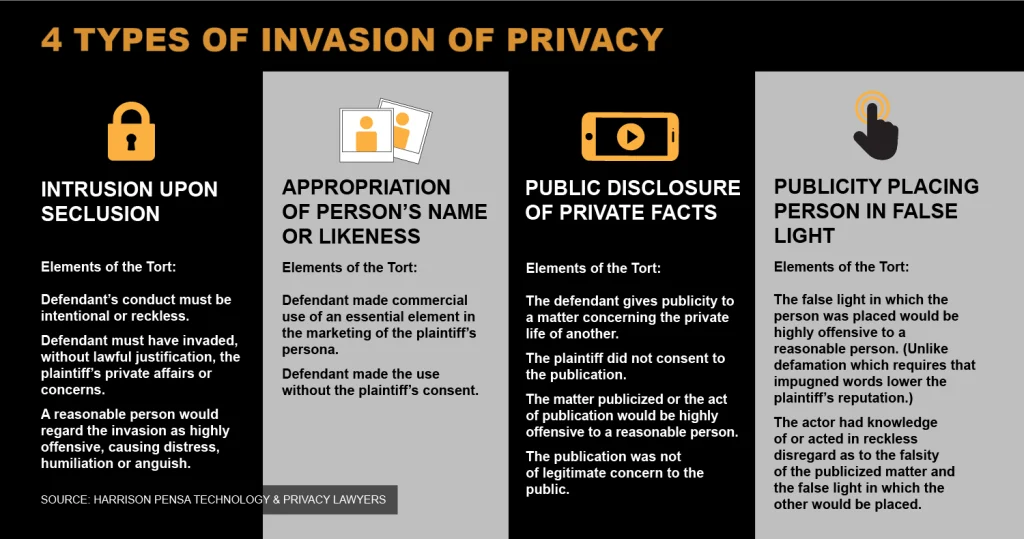17 August, 2021

Not long ago, we could not sue for invasion of privacy in Ontario. That has changed with the adoption of four new privacy torts — three of them in the past decade. All four torts originate in American law.
The American jurisprudence on privacy torts started in 1960 with Professor William Prosser’s article titled “Privacy” in the 1960 California Law Review which outlined four privacy torts:
- Intrusion upon seclusion;
- Appropriation of a person’s name or likeness;
- Public disclosure of private facts; and
- Publicity placing person in false light.
In 1977, the American Law Institute added the four privacy torts to their Restatement of the Law.
Ontario Courts have slowly adopted the privacy torts from the Restatement. A brief outline of each one is below. It is noteworthy that these torts are not aimed at corporate or institutional breaches of personal information.
1. Intrusion upon seclusion
Case introducing the Tort: Jones v Tsige 2012
Facts: The Defendant was a bank employee who used her work computer to access the Plaintiff’s bank account. The Plaintiff was the Defendant’s common law spouse’s ex-wife. She did not publish or record the information in any way.
Elements of the Tort:
- Defendant’s conduct must be intentional or reckless
- The Defendant must have invaded, without lawful justification, the Plaintiff’s private affairs or concerns
- A reasonable person would regard the invasion as highly offensive, causing distress, humiliation or anguish.
2. Appropriation of a person’s name or likeness
Case introducing the Tort: Athans v Canadian Adventure Camps Ltd et al, 1977, affirmed in Jones v Tsige
Facts: The Plaintiff was a waterskier who had a characteristic and distinctive photograph of himself. The Defendants made a drawing of the Plaintiff’s photograph and used it to advertise a summer camp for children.
Elements of the Tort:
- Defendant made commercial usage of an essential element in the marketing of the Plaintiff’s persona
- Defendant made the usage without the Plaintiff’s Consent
3. Public disclosure of private facts
Case introducing the Tort: Doe 464533 v N.D. 2016, Doe 464533 v N.D. 2018
Facts: In both cases, the Defendant posted a sexually explicit video of the Plaintiff online without the Plaintiff’s consent.
Elements of the Tort:
- The Defendant gives publicity to a matter concerning the private life of another
- The Plaintiff did not consent to the publication
- The matter publicized or the act of publication would be highly offensive to a reasonable person
- The publication was not of legitimate concern to the public
4. Publicity placing person in false light
Case introducing the Tort: Yenovkian v Gulian 2019
Facts: The Defendant posted Youtube Videos cyberbullying his children and their mother by falsely claiming that their daughter, who has a neurological disorder, looked “drugged” and that she used to be “normal”.
Elements of the Tort:
The false light in which the person was placed would be highly offensive to a reasonable person. (The Court distinguished this from defamation which requires that the impugned words lower the reputation of the plaintiff. The false light tort only requires a reasonable person to find it “highly offensive”.)
The actor had knowledge of or acted in reckless disregard as to the falsity of the publicized matter and the false light in which the other would be placed
Damages
For the most part, the amount of damages that can be recovered under these torts is relatively modest. In Jones, damages for the intrusion upon seclusion tort were capped at $20,000. But in the Yenovkian false light case, $100,000 in damages were assessed.
While these torts are fairly narrow in scope, and may have limited damages, they can be useful in the right circumstances.

David Canton is a business lawyer and trademark agent at Harrison Pensa with a practice focusing on technology, privacy law, technology companies and intellectual property. Connect with David on LinkedIn and Twitter.
Hamad Siddiqui completed his articles at Harrison Pensa and joined the firm as a civil litigation lawyer. Connect with Hamad on LinkedIn.
Image credit: ©Golib Tolibov – stock.adobe.com





